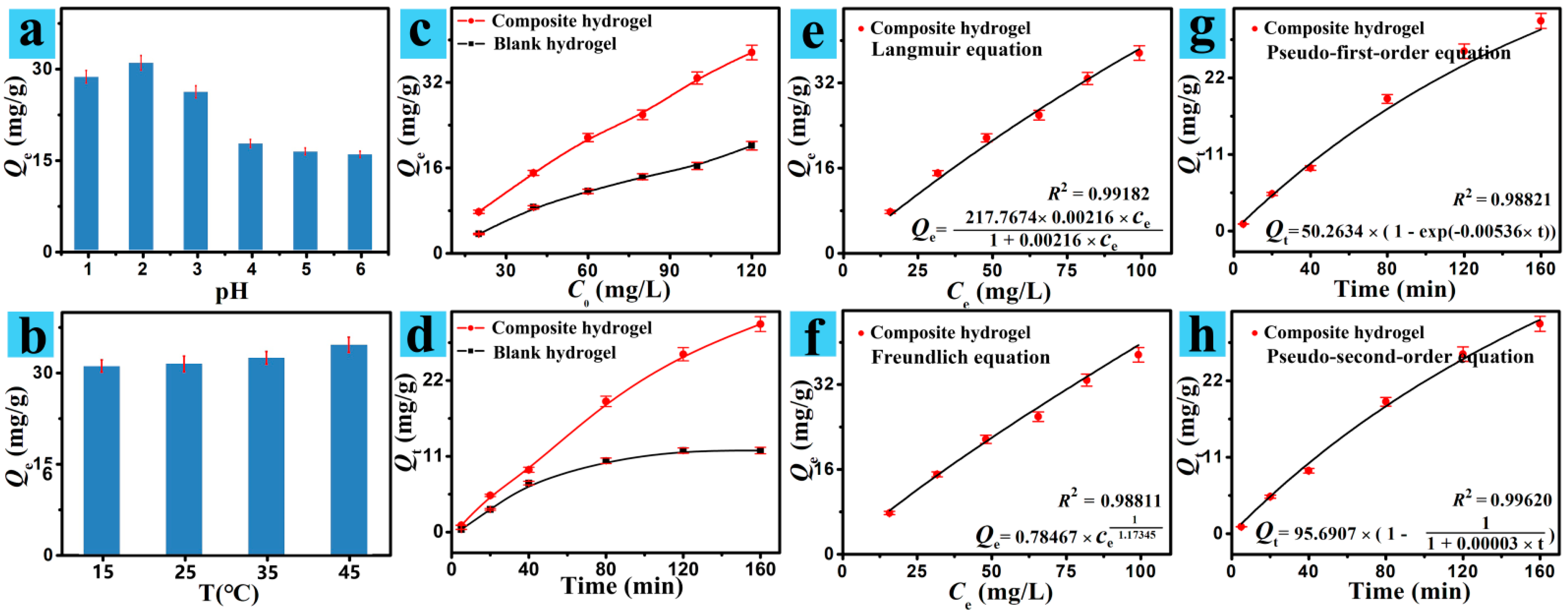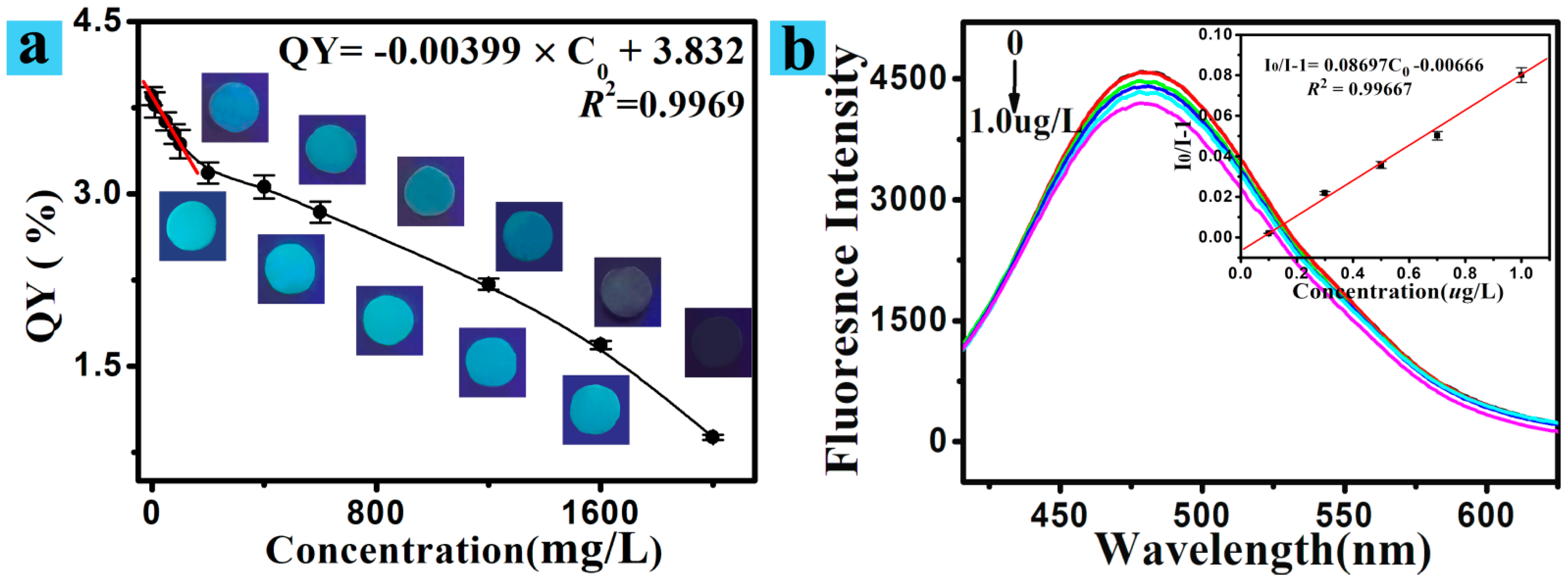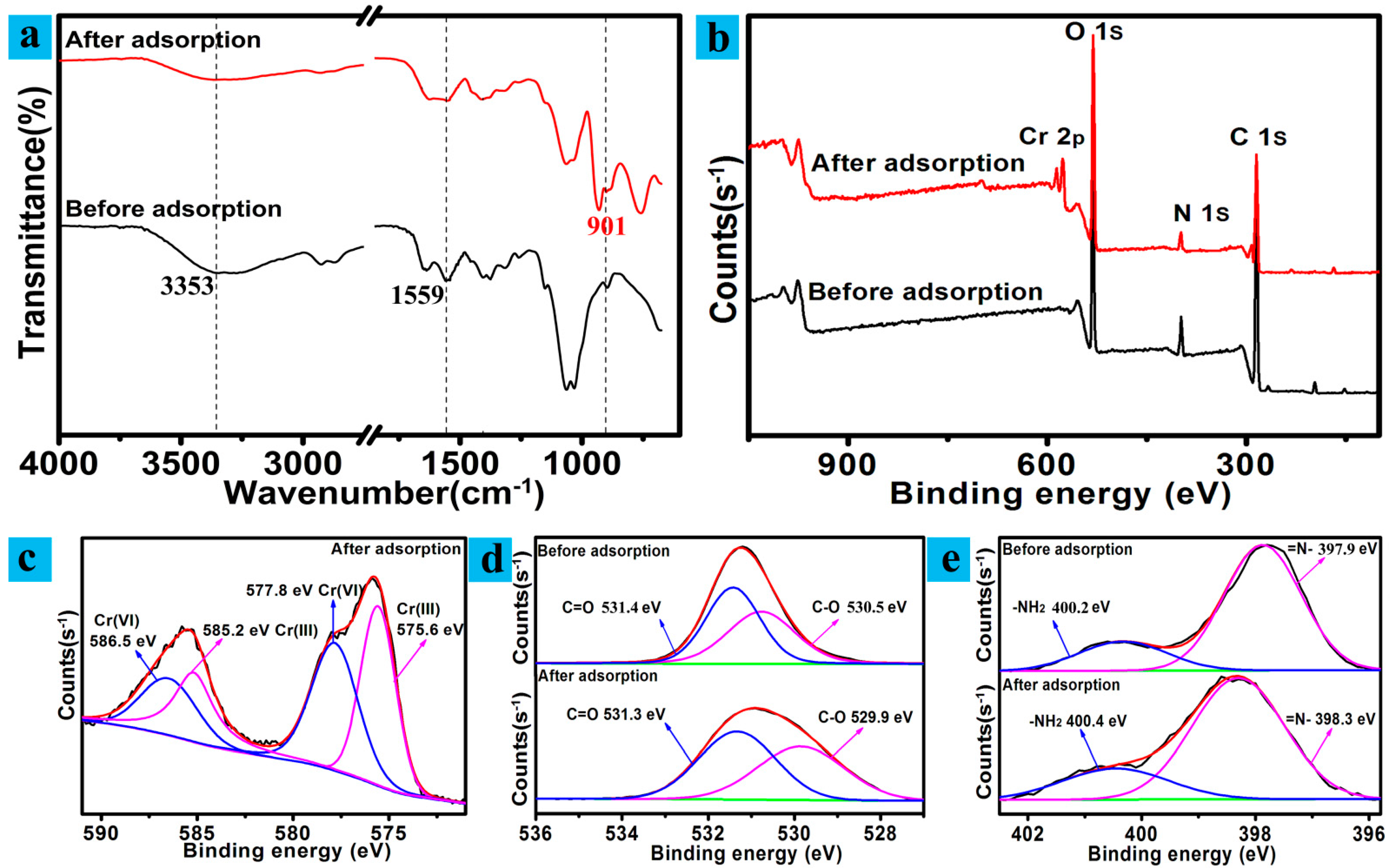Effective Adsorption and Sensitive Detection of Cr(VI) by Chitosan/Cellulose Nanocrystals Grafted with Carbon Dots Composite Hydrogel
Abstract
:1. Introduction
2. Materials and Methods
2.1. Materials
2.2. Synthesis of CN
2.3. Synthesis of CD
2.4. Synthesis of CNCD
2.5. Fabrication of CS/CNCD Composite Hydrogel
2.6. Batch Sorption Experiment
2.7. Instruments
3. Results
3.1. Schematic Diagram
3.2. Characterization
3.3. Sorption of Cr(VI)
3.4. Fluorescence Detection
3.5. Cr(VI) Sorption and Detection Mechanism
3.6. Economic Feasibility
4. Conclusions
Supplementary Materials
Author Contributions
Funding
Institutional Review Board Statement
Informed Consent Statement
Data Availability Statement
Conflicts of Interest
References
- Godiya, C.B.; Cheng, X.; Li, D.; Chen, Z.; Lu, X. Carboxymethyl cellulose/polyacrylamide composite hydrogel for cascaded treatment/reuse of heavy metal ions in wastewater. J. Hazard. Mater. 2019, 364, 28–38. [Google Scholar] [CrossRef] [PubMed]
- Park, S.; Shin, S.S.; Park, C.H.; Jeon, S.; Gwon, J.; Lee, S.; Kim, S.; Kim, H.; Lee, J. Poly(acryloyl hydrazide)-grafted cellulose nanocrystal adsorbents with an excellent Cr(VI) adsorption capacity. J. Hazard. Mater. 2020, 394, 122512. [Google Scholar] [CrossRef] [PubMed]
- Sigroha, S.; Khatkar, A. Chitosan—A naturally derived antioxidant polymer with diverse applications. Curr. Org. Chem. 2017, 21, 333–341. [Google Scholar] [CrossRef] [Green Version]
- Pavithra, S.; Thandapani, G.; Sugashini, S.; Sudha, P.N.; Alkhamis, H.H.; Alrefaei, A.F.; Almutairi, M.H. Batch adsorption studies on surface tailored chitosan/orange peel hydrogel composite for the removal of Cr(VI) and Cu(II) ions from synthetic wastewater. Chemosphere 2021, 271, 129415. [Google Scholar] [CrossRef] [PubMed]
- Hao, D.; Liang, Y. Adsorption of Cu2+, Cd2+ and Pb2+ in wastewater by modified chitosan hydrogel. Environ. Technol. 2020. [Google Scholar] [CrossRef]
- Liu, Y.; Hu, L.; Yao, Y.; Su, Z.; Hu, S. Construction of composite chitosan-glucose hydrogel for adsorption of Co2+ ions. Int. J. Biol. Macromol. 2019, 139, 213–220. [Google Scholar] [CrossRef]
- Tang, S.; Yang, J.; Lin, L.; Peng, K.; Chen, Y.; Jin, S.; Yao, W. Construction of physically crosslinked chitosan/sodium alginate/calcium ion double-network hydrogel and its application to heavy metal ions removal. Chem. Eng. J. 2020, 393, 124728. [Google Scholar] [CrossRef]
- Isogai, A.; Saito, T.; Fukuzumi, H. TEMPO-oxidized cellulose nanofibers. Nanoscale 2011, 3, 71–85. [Google Scholar] [CrossRef]
- Li, Y.; Miao, P.; Zhou, W.; Gong, X.; Zhao, X. N-doped carbon-dots for luminescent solar concentrators. J. Mater. Chem. A. 2017, 5, 21452–21459. [Google Scholar] [CrossRef]
- Ganguly, S.; Das, P.; Itzhaki, E.; Hadad, E.; Gedanken, A.; Margel, S. Microwave-synthesized polysaccharide-derived carbon dots as therapeutic cargoes and toughening agents for elastomeric gels. ACS Appl. Mater. Interfaces 2020, 12, 51940–51951. [Google Scholar] [CrossRef]
- Zhang, Y.; Li, C.; Sun, L.; Zhang, J.; Yang, X.; Ma, H. Defects coordination triggers red-shifted photoluminescence in carbon dots and their application in ratiometric Cr(VI) sensing. Microchem. J. 2021, 169, 106552. [Google Scholar] [CrossRef]
- Ganguly, S.; Das, P.; Das, S.; Ghorai, U.; Bose, M.; Ghosh, S.; Mondal, M.; Das, A.K.; Banerjee, S.; Das, N.C. Microwave assisted green synthesis of Zwitterionic photolumenescent N-doped carbon dots: An efficient ‘on-off’ chemosensor for tracer Cr(+6) considering the inner filter effect and nano drug-delivery vector. Colloid. Surf. A 2019, 579, 123604. [Google Scholar] [CrossRef]
- Yang, X.; Hu, D.; Zhang, P.; Ding, H.; Ji, Y.; Zou, H.; Li, B.; Wei, J.; Wei, X. Integrated carbon dots-matrix structures: An efficient strategy for high-performance electric double layer capacitors. ACS Appl. Energy Mater. 2020, 3, 4958–4964. [Google Scholar] [CrossRef]
- Luo, Q.; Yuan, H.; Zhang, M.; Jiang, P.; Liu, M.; Xu, D.; Guo, X.; Wu, Y. A 3D porous fluorescent hydrogel based on amino-modified carbon dots with excellent sorption and sensing abilities for environmentally hazardous Cr(VI). J. Hazard. Mater. 2021, 401, 123432. [Google Scholar] [CrossRef] [PubMed]
- Ujihara, M.; Hsu, M.; Liou, J.; Imae, T. Hybridization of cellulose nanofiber with amine-polymers and its ability on sick house syndrome gas decomposition. J. Taiwan Inst. Chem. E 2018, 92, 106–111. [Google Scholar] [CrossRef]
- Zhu, S.; Meng, Q.; Wang, L.; Zhang, J.; Song, Y.; Jin, H.; Zhang, K.; Sun, H.; Wang, H.; Yang, B. Highly photoluminescent carbon dots for multicolor patterning, sensors, and bioimaging. Angew. Chem. Int. Ed. 2013, 52, 3953–3957. [Google Scholar] [CrossRef]
- Wu, B.; Zhu, G.; Dufresne, A.; Lin, N. Fluorescent aerogels based on chemical crosslinking between nanocellulose and carbon dots for optical sensor. ACS Appl. Mater. Interfaces 2019, 11, 16048–16058. [Google Scholar] [CrossRef]
- Han, X.; Liu, Y.; Xiong, L.; Huang, H.; Zhang, Q.; Li, L.; Yu, X.; Wei, L. Facile assembly of Polyaniline/Graphene oxide composite hydrogels as adsorbent for Cr(VI) removal. Polym. Compos. 2019, 402, E1777–E1785. [Google Scholar] [CrossRef]
- Luo, Q.; Huang, X.; Luo, Y.; Yuan, H.; Ren, T.; Li, X.; Xu, D.; Guo, X.; Wu, Y. Fluorescent chitosan-based hydrogel incorporating titanate and cellulose nanofibers modified with carbon dots for adsorption and detection of Cr(VI). Chem. Eng. J. 2021, 407, 127050. [Google Scholar] [CrossRef]
- Demirci, N.; Demirel, M.; Dilsiz, N. Surface modification of PVC film with allylamine plasma polymers. Adv. Polym. Technol. 2014, 33, 21435. [Google Scholar] [CrossRef]
- Han, J.; Zhou, C.; Wu, Y.; Liu, F.; Wu, Q. Self-assembling behavior of cellulose nanoparticles during freeze-drying: Effect of suspension concentration, particle size, crystal structure, and surface charge. Biomacromolecules 2013, 14, 1529–1540. [Google Scholar] [CrossRef] [PubMed]
- Skwarczynska, A.; Kaminska, M.; Owczarz, P.; Bartoszek, N.; Walkowiak, B.; Modrzejewska, Z. The structural (FTIR, XRD, and XPS) and biological studies of thermosensitive chitosan chloride gels with -glycerophosphate disodium. J. Appl. Polym. Sci. 2018, 135, 46459. [Google Scholar] [CrossRef]
- Li, S.; Wang, X.; An, Q.; Xiao, Z.; Zhai, S.; Cui, L.; Li, Z. Upon designing carboxyl methylcellulose and chitosan-derived nanostructured sorbents for efficient removal of Cd(II) and Cr(VI) from water. Int. J. Biol. Macromol. 2020, 143, 640–650. [Google Scholar] [CrossRef] [PubMed]
- Luo, Q.; Ren, T.; Lei, Z.; Huang, Y.; Huang, Y.; Xu, D.; Wan, C.; Guo, X.; Wu, Y. Non-toxic chitosan-based hydrogel with strong adsorption and sensitive detection abilities for tetracycline. Chem. Eng. J. 2022, 427, 131738. [Google Scholar] [CrossRef]
- Geng, Z.; Zhang, H.; Xiong, Q.; Zhang, Y.; Zhao, H.; Wang, G. A fluorescent chitosan hydrogel detection platform for the sensitive and selective determination of trace mercury(II) in water. J. Mater. Chem. A. 2015, 3, 19455–19460. [Google Scholar] [CrossRef] [Green Version]
- Song, S.; Liang, F.; Li, M.; Du, F.; Dong, W.; Gong, X.; Shuang, S.; Dong, C. A label-free nano-probe for sequential and quantitative determination of Cr(VI) and ascorbic acid in real samples based on S and N dual-doped carbon dots. Spectrochim. Acta A 2019, 215, 58–68. [Google Scholar] [CrossRef]
- Li, W.; Wang, S.; Li, Y.; Ma, C.; Huang, Z.; Wang, C.; Li, J.; Chen, Z.; Liu, S. One-step hydrothermal synthesis of fluorescent nanocrystalline cellulose/carbon dot hydrogels. Carbohydr. Polym. 2017, 175, 7–17. [Google Scholar] [CrossRef]
- Maity, J.; Ray, S.K. Enhanced adsorption of Cr(VI) from water by guar gum based composite hydrogels. Int. J. Biol. Macromol. 2016, 89, 246–255. [Google Scholar] [CrossRef]
- Abdel-Halim, E.S.; Al-Deyab, S.S. Hydrogel from crosslinked polyacrylamide/guar gum graft copolymer for sorption of hexavalent chromium ion. Carbohydr. Polym. 2011, 86, 1306–1312. [Google Scholar] [CrossRef]
- Yuan, H.; Yang, G.; Luo, Q.; Xiao, T.; Zuo, Y.; Guo, X.; Xu, D.; Wu, Y. A 3D net-like structured fluorescent aerogel based on carboxy-methylated cellulose nanofibrils and carbon dots for a highly effective adsorbent and sensitive optical sensor of Cr(VI). Environ. Sci. Nano 2020, 7, 773–781. [Google Scholar] [CrossRef]
- Zhou, G.; Luo, J.; Liu, C.; Chu, L.; Ma, J.; Tang, Y.; Zeng, Z.; Luo, S. A highly efficient polyampholyte hydrogel sorbent based fixed-bed process for heavy metal removal in actual industrial effluent. Water Res. 2016, 89, 151–160. [Google Scholar] [CrossRef] [PubMed]
- Mei, J.; Zhang, H.; Li, Z.; Ou, H. A novel tetraethylenepentamine crosslinked chitosan oligosaccharide hydrogel for total adsorption of Cr(VI). Carbohydr. Polym. 2019, 224, 115154. [Google Scholar] [CrossRef]
- Vilela, P.B.; Dalalibera, A.; Duminelli, E.C.; Becegato, V.A.; Paulino, A.T. Adsorption and removal of chromium (VI) contained in aqueous solutions using a chitosan-based hydrogel. Environ. Sci. Pollut. Res. 2019, 26, 28481–28489. [Google Scholar] [CrossRef] [PubMed]
- Mirabedini, M.; Kassaee, M.Z.; Poorsadeghi, S. Novel magnetic chitosan hydrogel film, Cross-Linked with glyoxal as an efficient adsorbent for removal of toxic Cr(VI) from water. Arab. J. Sci. Eng. 2017, 42, 115–124. [Google Scholar] [CrossRef]
- Adebayo, G.B.; Adegoke, H.I.; Fauzeeyat, S. Adsorption of Cr(VI) ions onto goethite, activated carbon and their composite: Kinetic and thermodynamic studies. Appl. Water Sci. 2020, 10, 213. [Google Scholar] [CrossRef]
- Yi, N.; Wu, Y.; Wei, J.; Zhang, S.; Ji, P. Adsorption of the low concentration Cr (VI) on magnetic chitosan/PVA hydrogel beads. Fresen. Environ. Bull. 2016, 25, 2174–2182. [Google Scholar]
- Tekay, E.; Sen, S.; Aydinoglu, D.; Nugay, N. Biosorbent immobilized nanotube reinforced hydrogel carriers for heavy metal removal processes. e-Polymers 2016, 16, 15–24. [Google Scholar] [CrossRef]
- Tekay, E.; Aydinoglu, D.; Sen, S. Effective adsorption of Cr(VI) by high strength chitosan/montmorillonite composite hydrogels involving spirulina Biomass/Microalgae. J. Polym. Environ. 2019, 27, 1828–1842. [Google Scholar] [CrossRef]
- Kuang, W.; Tan, Y.; Fu, L. Adsorption kinetics and adsorption isotherm studies of chromium from aqueous solutions by HPAM-chitosan gel beads. Desalin. Water Treat. 2012, 45, 222–228. [Google Scholar] [CrossRef]
- Zhou, G.; Luo, J.; Liu, C.; Chu, L.; Crittenden, J. Efficient heavy metal removal from industrial melting effluent using fixed-bed process based on porous hydrogel adsorbents. Water Res. 2018, 131, 246–254. [Google Scholar] [CrossRef]
- Li, R.; Liang, W.; Li, M.; Jiang, S.; Huang, H.; Zhang, Z.; Wang, J.J.; Awasthi, M.K. Removal of Cd(II) and Cr(VI) ions by highly cross-linked thiocarbohydrazide-chitosan gel. Int. J. Biol. Macromol. 2017, 104, 1072–1081. [Google Scholar] [CrossRef] [PubMed]
- Roman, S.; Valente Nabais, J.M.; Ledesma, B.; Gonzalez, J.F.; Laginhas, C.; Titirici, M.M. Production of low-cost adsorbents with tunable surface chemistry by conjunction of hydrothermal carbonization and activation processes. Microporous Mesoporous Mater. 2013, 165, 127–133. [Google Scholar] [CrossRef]







| Sample | Heavy Metals | Qm (mg/g) | References |
|---|---|---|---|
| Tetraethylenepentamine crosslinked chitosan oligosaccharide hydrogel | Cr(VI) | 150.5 | [32] |
| Chitosan-based hydrogel | Cr(VI) | 93.0 | [33] |
| Fe3O4 NPs/CS/glyoxal hydrogel | Cr(VI) | 27.3 | [34] |
| Activated carbon | Cr(VI) | 5.46 | [35] |
| Magnetic chitosan/PVA hydrogel | Cr(VI) | 2.2 | [36] |
| Chitosan composite hydrogel | Cr(VI) | 66.9 | [37] |
| Chitosan/montmorillonite composite hydrogel | Cr(VI) | 78.0 | [38] |
| HPAM-chitosan gel bead | Cr(VI) | 66.1 | [39] |
| The CS/CNCD composite hydrogel | Cr(VI) | 217.8 | This work |
Publisher’s Note: MDPI stays neutral with regard to jurisdictional claims in published maps and institutional affiliations. |
© 2021 by the authors. Licensee MDPI, Basel, Switzerland. This article is an open access article distributed under the terms and conditions of the Creative Commons Attribution (CC BY) license (https://creativecommons.org/licenses/by/4.0/).
Share and Cite
Zeng, H.; Hu, Z.; Peng, C.; Deng, L.; Liu, S. Effective Adsorption and Sensitive Detection of Cr(VI) by Chitosan/Cellulose Nanocrystals Grafted with Carbon Dots Composite Hydrogel. Polymers 2021, 13, 3788. https://doi.org/10.3390/polym13213788
Zeng H, Hu Z, Peng C, Deng L, Liu S. Effective Adsorption and Sensitive Detection of Cr(VI) by Chitosan/Cellulose Nanocrystals Grafted with Carbon Dots Composite Hydrogel. Polymers. 2021; 13(21):3788. https://doi.org/10.3390/polym13213788
Chicago/Turabian StyleZeng, Hua, Zhiyuan Hu, Chang Peng, Lei Deng, and Suchun Liu. 2021. "Effective Adsorption and Sensitive Detection of Cr(VI) by Chitosan/Cellulose Nanocrystals Grafted with Carbon Dots Composite Hydrogel" Polymers 13, no. 21: 3788. https://doi.org/10.3390/polym13213788
APA StyleZeng, H., Hu, Z., Peng, C., Deng, L., & Liu, S. (2021). Effective Adsorption and Sensitive Detection of Cr(VI) by Chitosan/Cellulose Nanocrystals Grafted with Carbon Dots Composite Hydrogel. Polymers, 13(21), 3788. https://doi.org/10.3390/polym13213788





